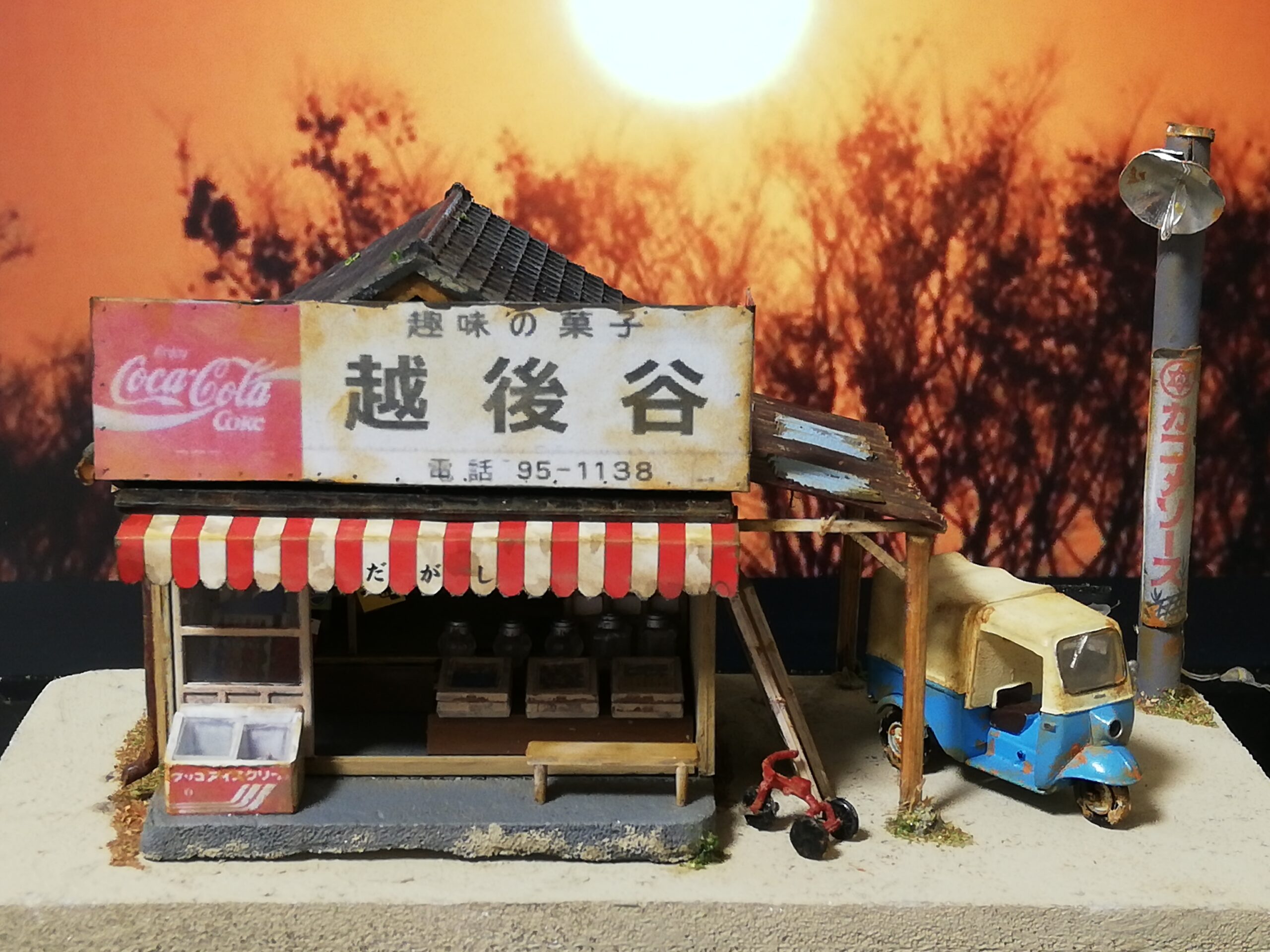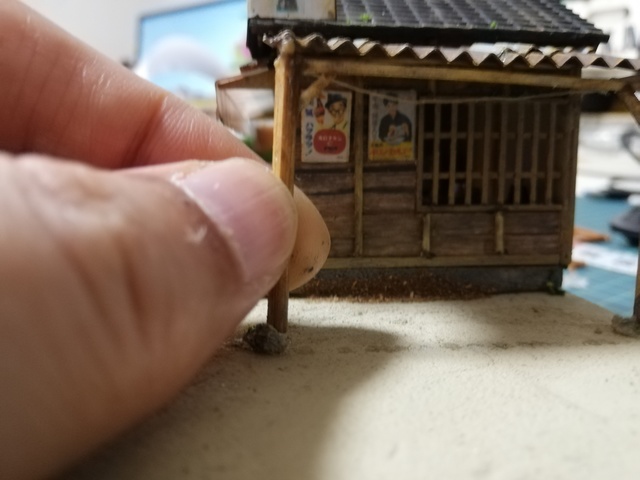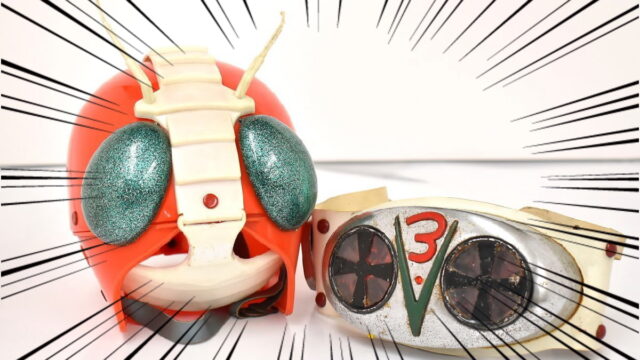初期作品の方が哀愁がある
The early work is more melancholy
フェイスブックというのは、1年前の投稿などを「振り返る」という目的で自分だけに表示してくれる機能があります。
ちょうど1年前に投稿した当時の作品が表示され、しみじみと見入っていると、あることに気が付きました。
実は、この作品はコンテストで入賞したものです。
Facebook has a function that displays posts from a year ago only for the purpose of “looking back”. I noticed that the work I posted just a year ago was displayed, and I was staring at it. Actually, this work won a prize in the contest.
初期作品と最近の作品
Comparison of early works and recent works
<初期作品>early works

<最近の作品>recent works

この2つの作品を見比べてみてください。
初期作品の方が「哀愁」があるように感じるのは私だけでしょうか?
ディテールを細かく作っているのは、最近の作品です。
それなりにリアルですが、細かなアイテムがあまり揃っていない初期作品の方が、どことなくいい雰囲気に見えてしまいます。
Please compare these two works.
Am I the only one who feels more “sorrowful” in the early works?
It is a recent work that makes the details finely.
It’s realistic as it is, but the early works, which don’t have many small items, look somewhat nicer.
初期作品の方が哀愁が漂う理由
The reason why the early works are more melancholy
もう一度、初期作品をご覧ください。
作品には、駄菓子屋の裏手にはトタン塀がありません。
Please see the early works again.
In the work, there is no tin fence behind the candy store.

最近作品には、トタン塀があります。
トタン塀には、ホーロー看板等を配置しています。それが、昭和の雰囲気を出しています。
昭和の雰囲気を出すトタン塀が無くても「哀愁」を出している理由は、トタン塀が無いことで「奥行」が生まれたからだと思います。
Recently, there is a galvanized iron fence in the work.
Enamel signs, etc. are placed on the galvanized iron wall. That gives the atmosphere of the Showa era.
I think that the reason why “sorrow” is given even if there is no galvanized iron fence that gives the atmosphere of the Showa era is that “depth” was born because there was no galvanized iron fence.
奥行の役割 The role of depth
奥行といっても、作品を置いた先には現実世界の空間が広がるだけです。
たとえば、こんな感じです。
これも、入賞作品と同じ構図で作ったものですが、裏手にはトタン塀はありません。
Even though it is called depth, the space in the real world only expands beyond the place where the work is placed.
For example, it looks like this.
This is also made with the same composition as the winning work, but there is no galvanized iron fence behind it.

この写真のように、机の上に置けば奥に見えるのはカッターマットであったり、キーボードの端だったりと… 奥には、作品にそぐわない現実があるだけです。
それでも、見る人は、その奥行に「その先の光景」を想像するのではないでしょうか?
目には、キーボードが映っていても、頭の中ではすすきや夕景、田園風景といった自分の懐かしい情景を想像するのではないでしょうか?
その想像されたイメージと目の前にある作品がさらに頭の中で融合して、私の場合は、それを「哀愁」として作品から感じるのではないでしょうか?
この「その先の光景」をストップさせてしまうのがトタン塀なのです。
トタン塀は”ここで行き止まり”というような連想をさせてしまいます。
その結果、見る人の「その先の光景」を自然と想像できなくさせてしまいます。
「その先の光景」を想像しないので、作品と自分の懐かしい情景を想像した映像との融合が起きず、作品だけを見ることになります。
その結果、作品が放つ哀愁感が薄れるのかもしれません。
では、もう一度、トタン塀ありの作品をご覧ください。
As you can see in this photo, if you put it on your desk, you can see the cutter mat in the back, the edge of the keyboard, and so on … There is only a reality in the back that does not match the work.
Still, the viewer may imagine “the scene beyond” in the depth.
Even if you can see the keyboard in your eyes, you can imagine your nostalgic scenes such as plows, evening scenes, and rural scenery in your head.
The imaginary image and the work in front of me are further fused in my head, and in my case, I feel it as “sorrow” from the work.
It is the galvanized iron fence that stops this “scene beyond”.
The galvanized iron wall is associated with something like “a dead end here”.
As a result, the viewer’s “scenery beyond” is naturally unimaginable.
Since I don’t imagine the “scene beyond”, the fusion of the work and the image that imagines my nostalgic scene does not occur, and I only see the work.
As a result, the melancholy of the work may diminish.
Then, please see the work with the galvanized iron wall again.

いかがでしょうか? 哀愁感、ありますか?
こちらの方が、哀愁感あると思いませんか?
What do you think? Do you have a feeling of melancholy?
Don’t you think this is more melancholy?

この気付きは「宝」かもしれません。
こまごまとアイテムを増やしてリアルにすることは大切なことですが、引き算をすることも忘れてはいけないと気が付きました。
This awareness may be a “treasure.”
It’s important to increase the number of items and make them real, but I realized that I shouldn’t forget to subtract.
写真撮影の場合 For photography
その先の光景を想像させるためのテクニックがあります。
つまり、いくら先が想像できるといっても、カッターマットやキーボードが視界に入ってきては、作品の邪魔をしてしまいます。
そんな時は、ある程度、拡大して作品を撮影します。
たとえば、こんな風に撮影します。
- 電信柱を上まで入れない。
- 横端から横端まですべてを画角におさめない。
これは、私のお友達が加工してくださった写真です。お友達はそんなヒントをくれました。
There is a technique to make you imagine the scene beyond that.
In other words, no matter how far you can imagine, if the cutter mat or keyboard comes into view, it will interfere with your work.
In such a case, I will enlarge the work to some extent and shoot the work.
For example, shoot like this.
- Do not insert the telephone pole all the way up.
- Do not fit everything from the horizontal edge to the horizontal edge in the angle of view.
This is a photo processed by a friend of mine. My friend gave me such a hint.

なるほど、切れた電柱やミゼットの先を想像したくなります。
結果的にそれが、その先の光景を頭の中で描かせるきっかけになると思うのです。
Indeed, it makes me want to imagine the tip of a broken utility pole or midget.
As a result, I think that will be an opportunity to draw the scene beyond that in my head.
入賞作品の写真にもこの方法が当てはまっていた!
これは、ホビコムの模型コンテストで入賞した時の作品写真です。





私自身、この法則に気が付いて過去の入賞作品を見て驚きました!
すべて丸ごと画角におさまった写真は1枚もないのです!
当時は、それを意図せず、これがいい雰囲気だなと写真を撮ったことを覚えています。
いい雰囲気とは、全体がすべて入った写真ではないということです。
その先の光景を想像させる演出があるかどうかなのだと思います。
偶然とはいえ、応募した作品の写真は、私がいい雰囲気だと感じて撮ったスナップです。
たまたま、すべて画角に納まらない写真ばかりでした。
それが、その先の光景を想像させる演出になってしまっていたのでした。
そんな写真で応募したコンテストにこの作品は入賞しました。
作者の意図せぬところではありましたが、そうした画角におさまらない写真は、審査員の方々の「その先の光景」を想像させることに働きかけたのだと思います。
コンテストの入賞は、この法則の何よりの証明だと思います。
これからは、意識してこの法則を使っていこうと思います。
- 視線の先を遮るような塀や壁を作品には作らない。
- 塀や壁は視線と同じ方向に延びるように作ること。
- 完成した作品は、すべてをおさめるように撮影はしない。
- 電柱であればてっぺんまでを入れない、家屋であればその一部分をといった具合に、その先を連想させやすい見切れ方で撮影をすること。
例えば、横断歩道を描く(いた)作品の場合…
写真の時は、途中までしか画角に入れずに撮影する。作品の場合は、すべてを描かず、道が途中で切れているといった具合にします。そのようにすると、写真でもリアルの作品にも「その先の光景」を想像させるキッカケを見てくれる人に与えることができます。












